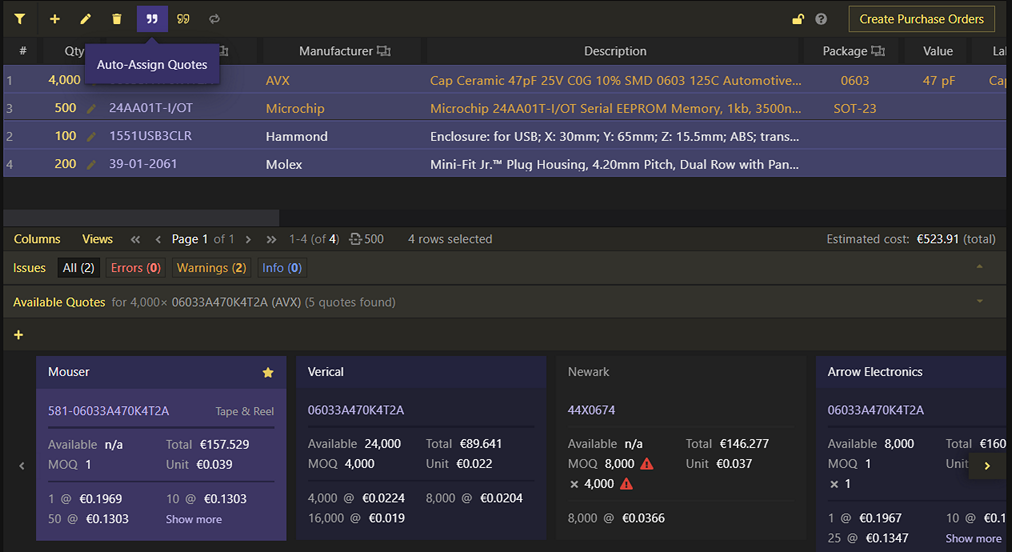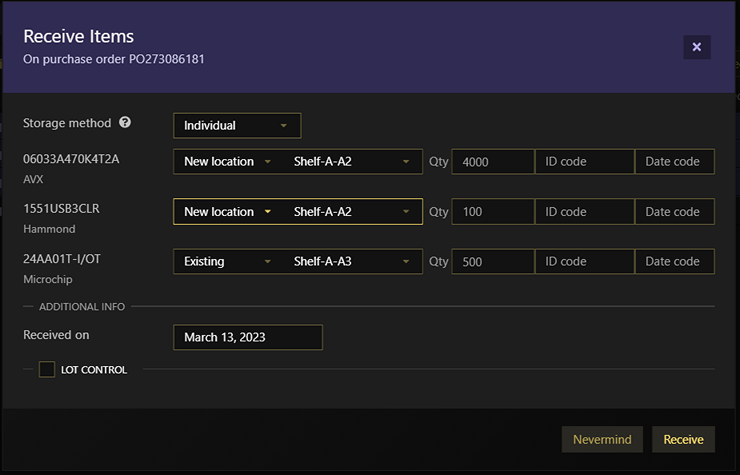Purchasing
Purchasing helps you keeping track of the parts that you need or simply want to buy. Purchase lists allow you to list those parts and quantities while helping on deciding from which suppliers you want to buy them from, based on pricing and/or availability. Once you know from which suppliers you are ordering your parts, you create purchase orders that allow you to track the order itself on the supplier.
Suppliers
Thanks to Nexar API (formerly Octopart API), the app has access to real-time pricing from several online suppliers and distributors such as DigiKey, Mouser, TME, Farnell, LCSC, etc. However, you can also define custom suppliers and quotes through Suppliers.
Through Settings > Workspace > Quotes you can define your preferred suppliers and in which order so when auto-assigning qutotes the app will take that into consideration.
The app never places actual orders on suppliers. Instead, the app serves only as a way to better manage and plan your purchases. Once you know which parts need to be purchased and from which suppliers, it's up to you to actually place the orders on the selected suppliers and to update data on the app accordingly.
Purchase lists
You can add parts into a purchase lists either by adding them straight from the purchase list, or from other tables on where you have parts, by (right-clicking and) Add to... > Purchase list. Once on a list your main task will be to find available quotes for all the parts and quantities that need to be purchased.
When you use the Add to... > Purchase List from the Parts table, by default the quantity to be added to the purchase list is the part's current stock balance, but only if negative.
You can also manually create a purchase order and add parts and quantities straight into it. However, doing that you skip selecting quotes and assume that those parts are available on a given supplier, regardless of its price. This might be valid if you know for sure that that's the case and are ok with it. In all other cases, this is not recommended.
Auto-assigning quotes
Fortunately, assigning parts to all items in a list can be done through a single click. All you have to do is to select the parts for which you want to auto-assign quotes and click on the Auto-assign quotes button.

This will take into consideration you preferred suppliers (defined through Settings > Workspace > Quotes) as well as the minimum order quantities (MOQs) and its price breaks.
Generic parts
Generic parts can be added into purchase lists and when quoting them the app will consider the quotes available for all its alternate parts. When a quote is picked, the generic part itself is replaced by the part the quote refers to.
Splitting quantities between suppliers
For one or more parts, you might find that you can't buy the full quantity you need from a single supplier. In this case, you can (right-click and) Split item... taking a quantity from the original line into a new one.
Moving quoted parts into purchase orders
Once parts have been quoted, they can be moved into one or more purchase orders. A purchase order is needed for every supplier listed on those quotes. In case a purchase order for a given supplier is already open (but not ordered) you'll have the option to add the parts and/or quantities into that existing order, or to create a new one.
You don't have to move all the parts in a purchase list into purchase orders all at once. When pressing the Create / Add To Purchase Order button, all currently open items that have a valid quote assigned are considered when moving them into a purchase order (regardless of currently selected items in the table). As you move quoted items into purchase orders, the items in the list will get a closed status and will be displayed with a striped gray background for easier identification.
In order to be able to move items in a purchase list into a purchase order, you purchase list cannot have any errors.
Purchase orders
Purchase orders track the purchases on a given supplier. A purchase order can be in one of 3 different states:
Initially the order is considered to be open: it should contain parts and quantities listed in it and might still accept other parts and quantities to be added before being actually placed in the supplier. Once the purchase order has been placed, it moves to the ordered state.
Receiving items
Once ordered, items must be individually marked as received. When doing so, you enter the storage location where they should be stored and inventory is automatically added to your stock.

Storage method and partial deliveries
When receiving items you can select one of these storage methods:
- Single location: stores inventory of all parts being received into a single storage location
- Individual: for every part being received, you can select a specific storage location but also the quantity being received (if only part of it is being received) as well set an ID and date codes for each inventory being received (learn more in traceability)

Optionally, a lot can also be created.
Once all items have been marked as received, the purchase order automatically transitions to the received state.
You can also mark the whole purchase order as received at any time, but any items on it not received yet will remain as such. This might be intentional as some items, even though initially purchased, for some reason might not be delivered but you'd still leave them listed on the purchase order for future reference.
